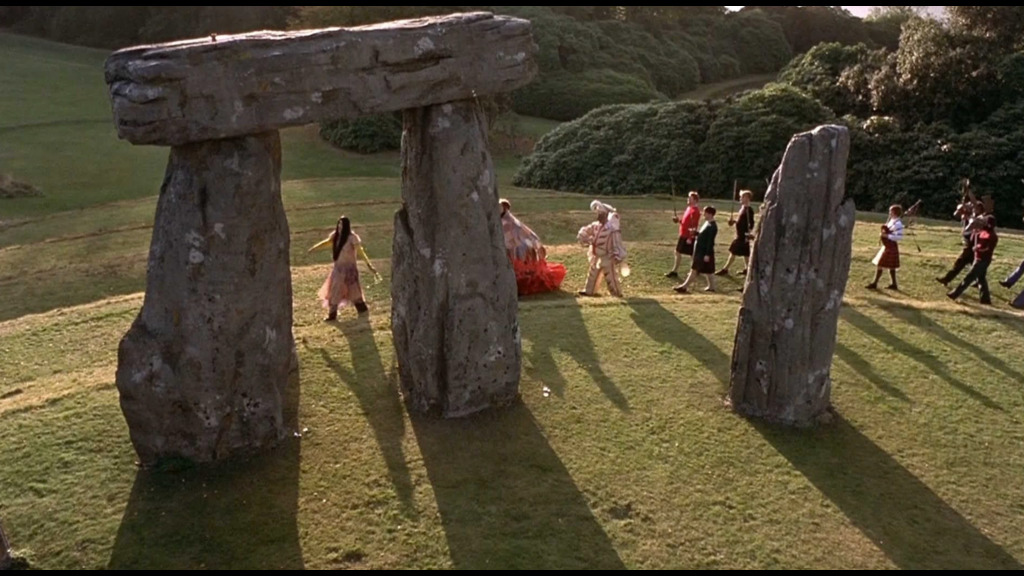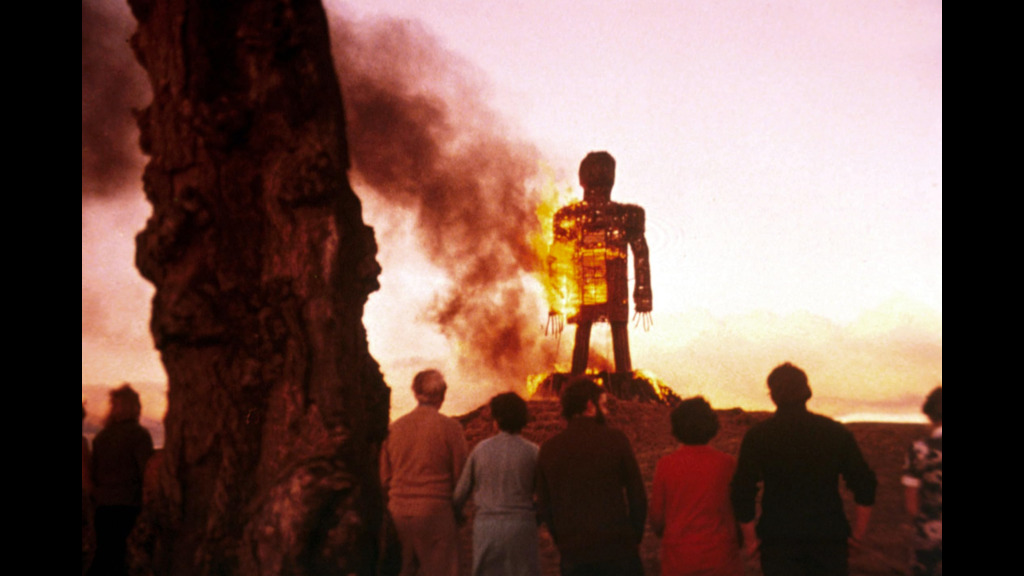|Sophie Durbin|

The Wicker Man plays at the Trylon Cinema from Sunday, October 19 to Tuesday, October 21. For tickets, showtimes, and other series information, visit trylon.org.
The Wicker Man begins like a typical “everyone in this town is hiding something” crime story. Sergeant Neil Howie arrives by seaplane to the fictional Hebridean island of Summerisle to investigate the disappearance of a young girl. He discovers that the locals, who seem ordinary at first, have abandoned Christianity and reverted to the nature-worshiping ways of their ancestors. Chaos ensues as the story transforms into no ordinary crime story: it’s the folk horror of all folk horrors. Director Robin Hardy and screenwriter Anthony Shaffer meticulously researched pagan religion in pre-Christian Scotland, and they were dead set on depicting pagan folk traditions realistically. Their work pays off. Even on a rewatch, when much of the edge has been sanded off if you know the twist, there are details that get under the skin: the jars full of human body parts in the pharmacy, the seemingly useless offering of ale to the sea god, or the row of photographs of each year’s May Queen, with this year’s ominously missing. Here’s the catch: Hardy and Shaffer used a mix of legitimate and now widely disproven sources to make the film. We actually know very little about pagan belief in early Scotland. If we review the archaeological record, as well as some key literary and folklore history sources, can we get a better sense of what’s “real” and what’s not? Let’s dig into why the information is quite so shaky, and then guide you through a few pagan themes in The Wicker Man and their real, or not-real, basis.
The Christian/Pagan Dynamic in Scotland
Tradition will tell you that Christianity arrived in now-Scotland with St. Columba,1 a 6th-century abbot from Ireland who established the still-extant monastery on Iona, a tiny island located in the Inner Hebrides near the Isle of Mull. However, the emergence of organized Christianity in Britain was chronologically messy, and much of Scotland was likely already converted by the time St. Columba washed up on the rocky shores of Iona and took the credit. Still, depictions of pagan activity in the hagiographical Life of Columba are some of the most important primary sources we have for paganism in the area. That some pagan practices maintained their shape amidst all the Christianization is commonly agreed upon; however, there’s likely nowhere that Iron Age sacrificial rituals lasted as the new religion took hold. The ancient memory of these pagan beliefs inspired The Golden Bough, a book on comparative religion written by James Frazer in 1890, which influenced everyone from Joseph Campbell to the Doors. While widely discredited by anthropologists today, Frazer’s work largely frames much of the pop culture definition of how pagan folk tradition would have been practiced, and it was a key text in Hardy and Shaffer’s research.
Summerisle
Summerisle is located in the Hebrides, an archipelago of islands off the west coast of Scotland. They are divided into the Inner and Outer Hebrides. The Outer Hebrides are notable for the considerable presence of Gaelic in the present day. Megalithic structures such as the Calanais Standing Stones on Lewis are visible across the landscape, often aligning with the winter solstice sun and reminding visitors of the pagan cosmology that once dominated.
Gods and Goddesses
Any reconstruction of a singular Celtic pantheon of gods and goddesses must be taken with a grain of salt, as these lists are often heavily influenced by Christian texts from centuries later than the worship in question. Still, Hardy and Shaffer show the teeth of their research when they have Lord Summerisle address “Shoney, God of the Sea.” “Shoney” is an Anglicization of Seonaidh, a water spirit local to the Isle of Lewis (Summerisle is a fictional neighbor to Lewis within the Hebridean archipelago). Martin Martin, Scotland’s best-named travel writer, documented the ale offering ritual for Seonidh during his travels to the western isles in the 18th century.
May Day
May Day is real, friends! To those of you reading in the Twin Cities, it’s not just our annual celebration of International Worker’s Day; it’s also an ancient holiday celebrated throughout Europe. Newcomers to the folk horror genre who have seen Midsommar may immediately recognize the May Day celebration in The Wicker Man as a key inspiration. It is also closely related to Beltane, the pagan spring holiday which is often celebrated with burning ceremonies. The weird mating rituals that disturb Sergeant Howie throughout the film are tied to May Day’s association with fertility. In James Frazer’s Golden Bough hypothesis, springtime fertility rites are linked with the rebirth of the sun and its apex at the summer solstice.
Human Sacrifice
There is evidence for human sacrifice in prehistoric pagan Europe, though it was far from a common practice. In Britain, we are lucky enough to have well-preserved bog bodies which appear to have been slaughtered and subsequently submerged. Consider Lindow Man, who was “almost certainly a ritual sacrifice; he was strangled, hit on the head, and had his throat cut, in quick order, then surrendered to the bog.” There are literary references to human sacrifice as well: in missionary Adam of Bremen’s description of the temple to the Norse gods at Uppsala in Sweden, he depicts a sacrificial grove, filled with the hanging bodies of animals and humans. Ibn Fadlan’s thrilling description of a Viking leader’s funeral along the Volga includes the sacrifice of one of his female slaves.2 With Christianization, the sacrifice of humans and animals was typically abandoned.

The Wicker Man
To elaborate on the human sacrifice theme, I am delighted to share that the particular version of sacrifice depicted in the climax of The Wicker Man is based on a short and vivid passage in Commentaries on the Gallic War, Julius Caesar’s account of his encounters with Celtic and Germanic tribes in Gaul in the years 58 – 50 BC. In the Commentaries, the Gauls conduct regular sacrifices of hundreds of people within a wooden structure to win the favor of the gods. Like many of our classical sources, Caesar’s description of the sacrifices cannot be taken at face value, and he likely heard about this kind of mass human sacrifice from other soldiers who fought in Gaul. To this date, I remain unaware of any Wicker Man-like structures miraculously preserved from antiquity.
Notes
- Keep in mind that Scotland as we know it did not exist in the Iron Age or medieval period; it consisted of numerous tribes and small kingdoms occupying land above Hadrian’s Wall. For brevity’s sake, I will refer to it as Scotland throughout this piece. ↩︎
- For a bang-up job depicting some of the most vivid of Ibn Fadlan’s observations, see The Northman. ↩︎
Edited by Finn Odum
